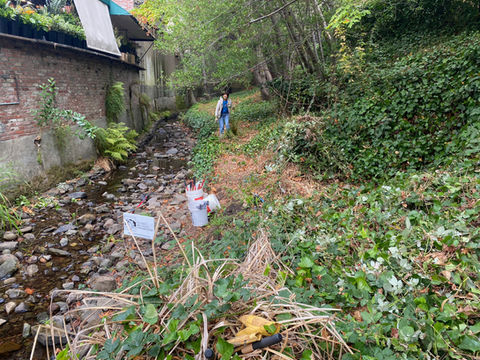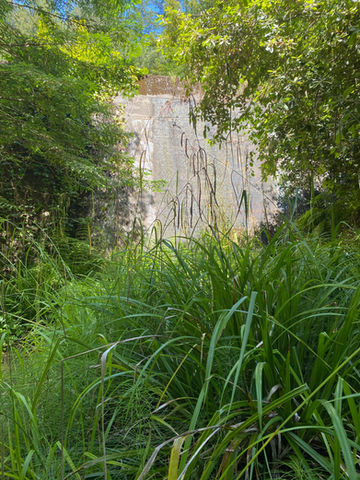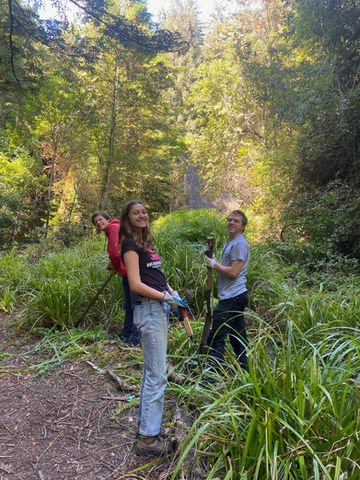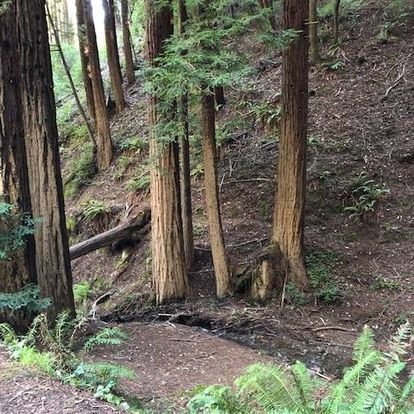
Welcome to Mill Valley StreamKeepers
Protecting & Improving Mill Valley's Watersheds since 1998
Chinook salmon near Old Mill Park, December 2024
JOIN US!
Next Volunteer Day Dec 13, 2025
Near bridge at Old Mill Park
10am
In early December 2024 there were 5-6 Salmon in Old Mill Creek near the bridge!
As seen on Nextdoor, there were multiple salmon in Old Mill Creek. It's likely that were Chinook salmon and over two feet long. Chinook are protected by the Endangered Species Act because they are rare. Please do not disturb or let your dog disturb or try to catch these or other salmon in Mill Valley creeks.
We reached out to fish experts like the CA Department of Fish and Wildlife about how to best protect them. The consensus is to let nature decide their fate.
Chinook appear by the Old Mill park bridge regularly. Coho have not been seen here for 50 years. There are also possible Steelhead salmon present now in the creek. Steelhead have white lips but usually show up from Jan to March. Chinook have black lips and splotchy spots.
These salmon are anadromous, meaning they start their life cycle in fresh water and then live in the ocean for a while before returning to their home creek to spawn.
One expert, Laura Chariton of watermarin.org, says that the Chinook are not generally or historically in this watershed. Many are showing up in our creeks because they are lost hatchery fish. Hatcheries remove the adipose fin on about 20% of their salmon. So, even if the Chinook salmon has an adipose fin, it does not mean that it comes from the wild.
It is a good sign that these fish have shown up here. It means we're getting sufficient winter rains which helps them to swim upstream. It also means that the creek is in decent but not great shape. Chariton adds that Mill Valley creeks lack complex deep pools, refugia created by woody debris, and oxygenating riffles for spawning. Our creeks are often channelized so that big storms generally wash away young fry and eggs.
As of Dec 15, 2024, the salmon are no longer in the pool near the bridge at Old Mill park.
There is an obstacle that prevents the salmon from moving further upstream where they want to go, even possibly beyond Three Wells! There are concrete barriers right under the bridge that prevents the salmon form moving up unless there is a lot of rain and water in the creek.
Mill Valley StreamKeepers, the City of Mill Valley and Hugh Kuhn have applied for federal grants to remove the barriers, but were not successful in a recent round of applications. We will hopefully apply again soon.


From Eric Ettlinger
Marin Water Aquatic Ecologist,
YouTube Video on the Transformation of Lagunitas Creek and the Record Number of Salmon there as of Dec 2024
And more from Eric
How to Report Spills or Illicit Discharges in MV waterways
Non-hazardous substance (paint, concrete, muddy or soapy water) during City work hours: Contact Public Works 415-384-4800, ask for Dante Romero
If discharge is hazardous or after City hours contact the MV Fire Department 415-388-8182
For spills outside City limits contact the Sheriff 415-473-7250
Please also report fish poaching or pollution to CA Dept of Fish & Wildlife at 888-334-2258
Our Mission Statement
The Mill Valley StreamKeepers is a community action group working to restore and protect Mill Valley’s Watersheds.
StreamKeepers Past Work Parties
Pictures from recent parties below:
Between OAC and MV Market Sept 2024
Old Mill Park Creek April 2024
Cascade Dam Removing Hanging Sedge Sept 2023
A big thank you and a warm goodbye to Phyliss Faber By Bill Kier At Mill Valley StreamKeepers’ July meeting our treasurer, Barbara Ford announced that we had received a generous contribution from the estate of longtime Mill Valley resident Phyliss Faber who passed away in January. I volunteered to prepare this tribute to Phyliss, who I knew professionally long before Helen and I settled in Mill Valley 40 years ago. I discovered, not surprisingly that there were a number of tributes to Phyliss already out there, including this excellent ‘Remembering Phyliss Faber’ in Bay Nature magazine by David Kupfer. David’s interview, as so many others, captures how Phyliss, a young mother of three whose husband’s work with the Xerox Corp. had them bouncing from New York to the Bay Area and back to various East Coast locations -- more than a dozen moves before they were able to settle, finally, in Mill Valley up near the golf course in 1970 – had to reinvent herself. A native of New York City, Phyliss had an undergraduate degree in zoology from Mount Holyoke and a graduate degree in microbiology from Yale, but with three youngsters to tend to long lab days studying the structure and function of DNA were necessarily behind her. Phyliss turned, instead, to teaching Marin schoolkids at the Audubon Canyon Ranch near Stinson Beach about our native plants, even as she was learning about the plants herself. By 1982 Phyliss had written and published Common Wetland Plants of Coastal California. Phyliss became an early activist for protection of the coastline and worked on the campaign for Proposition 20, the California Coastal Zone Conservation Act of 1972. With the passage of Proposition 20, Marin’s State Senator Peter Behr successfully recommended Phyliss’ appointment to the North Central Regional Coastal Conservation Commission. Phyliss also became an increasingly determined coastal wetlands restoration expert, who with Bay Area environmental consulting icon Phil Williams, designed the assessment scheme for the restoration of Muzzi Marsh, that intended to compensate for the 1970s dredging of the Larkspur ferry terminal. ‘Not to take readers too far ‘into the weeds’, but Phyliss was so determined to document whether and how Muzzi Marsh restoration was proceeding over time, whether it was truly compensating for the impacts of the ferry terminal development as intended, that she revisited the monitoring stations that she and Phil Williams had installed out in the marsh relentlessly over the decades. Phyliss Faber brought so much energy and goodwill to her adopted state and hometown that she’s still very much among us here in Mill Valley. Ours is, therefore, a warm goodbye, Phyliss, and a great big thank you!




























